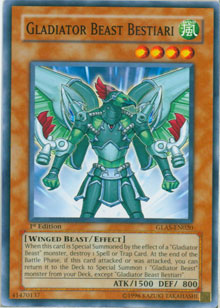The battle step really only has one typical "event-specific" chain: a monster declaring an attack. The choices made at this time also affect the choices made in the remainder of the battle step. Players can have a good reason to wait until after this event-specific chain has come and gone, but it isn’t always possible to wait if you are the player with the attacking monster.
The "Monster Declares an Attack" Chain
When a monster declares an attack, the game allows for one event-specific chain that can be used to respond to the attack. Any effect activated in this chain can respond to the attack, even in multiples. When building this chain, you must first deal with any continuous effects that "turn on" when the monster declares an attack (such as Ancient Gear Golem’s ability). After they are applied, any trigger effects that activate when the monster declares an attack (e.g. Gravekeeper’s Assailant, etc.) start the chain. Lastly, both players can activate effects that respond to the attack or have appropriate timing.
Example 2:
Player A has Neo-Spacian Glow Moss in face-up defense position. Player B attacks the Glow Moss with Gil Garth, causing Glow Moss’s trigger effect to activate and start a chain. Player A can chain Sakuretsu Armor to Neo-Spacian Glow Moss’s effect. When the chain resolves, Gil Garth is destroyed and Player B draws a card for Glow Moss’s effect, then applies whichever Glow Moss effect is appropriate.When trigger effects are absent, the turn player has priority and can start the chain with a spell speed 2 or higher effect. Given that the battle step has a bit of flexibility and you can activate multiple effects before moving on to the damage step, if the turn player intends to use cards that respond to the attack, then that player shouldn’t just pass and hope his or her opponent will do something. Passing on this opportunity is risky. If the opponent also passes, the chance to activate effects that respond to the attack closes and these types of cards cannot be activated during the remainder of the battle. When the turn player declares an attack, that player isn’t limited exclusively to spell speed 2 or higher effects that respond to the attack: it just isn’t in his or her best interest to use the non-specific effects straight away.
In all honesty, effects that activate in response to an attack tend to be controlled by the defending player. If the turn player controls this type of effect, it’s usually a trigger effect. Exarion Universe is one of the few non-trigger effects the attacking player would need to activate when that player declares his or her attack, because this is the only time its effect can be activated.
Example 1:
Player A has Exarion Universe in attack position. He declares an attack against his opponent’s defense-position monster. If Player A wants to activate Exarion Universe’s effect, he must do so at this time. If he passes, he will not be able to activate its effect. If he activates its effect, his opponent can chain an effect that responds to the attack, like Magic Cylinder.
If, instead, Player A passes on responding to the attack, Player B is given her chance to respond. If she declines—likely because her monster is the stronger of the two—the opportunity to respond to the attack would close and it wouldn’t be possible for her to use Sakuretsu Armor for the remainder of the battle. It is certainly in Player A’s best interests to pass on responding to the attack, leaving his opponent to guess at his true intentions for attacking.
The Battle Step Remains
After dealing with the event-specific chain of a monster declaring an attack, the battle step doesn’t immediately end. Both players can still activate effects. They  just can’t activate effects that can only be used in response to an attack.
just can’t activate effects that can only be used in response to an attack.
Example 1:
Player A attacks Player B with Dark Magician. Player B responds to the attack by activating Magic Cylinder, but Player A chains Seven Tools of the Bandit to negate it. After the chain resolves, Player B can activate Waboku sometime during the remainder of the battle step because it doesn’t need to be activated in response to an attack.During the remainder of the Battle Step, Player A can activate Enemy Controller to shift Mobius the Frost Monarch into defense position. When he does so, Player B will not be able to activate Sakuretsu Armor. She had the chance to activate it, but chose not to.
The battle step doesn’t immediately end just because no one activated effects that respond to the attack. You can still use the battle step to activate effects that don’t have attack-response specific effects. Don’t forget that you have this flexibility!
Next week: the Damage Step and event-specific chains. Until then, send all comments and questions to Curtis@Metagame.com.
—Curtis Schultz